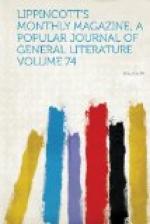In truth, the Old World’s fund of humanity is not sufficiently ample to keep up the pace; and the rate of natural increase is no longer what it was when the country was all new, and cornfield and nursery vied in fecundity. That the former source of augmentation is gaining in proportion upon the latter is apparent from the last three returns. The ratio of foreign-born inhabitants to the aggregate in 1850 was 9.68 per cent. in 1860, 13.16, and in 1870, 14.44. In the last-named year, moreover, 10,892,015, or 28 per cent. of the entire population, white and black, are credited with foreign parentage on one or both sides. Excluding the colored element, ranked as all native, this proportion rises to 32 per cent.
Judged by the test of language, three-fifths of those who are of foreign birth disappear from the roll of foreigners, 3,119,705 out of 5,567,229 having come from the British Isles and British America. Germany, including Bohemia, Holland and Switzerland, sums up 1,883,285; Scandinavia, 241,685; and France and Belgium, 128,955. The Celtic influx from Ireland, and the Teutonic and Norse together, form two currents of almost identical volume. Compared with either, the contribution of the Latin or the Romance races sinks into insignificance—an insignificance, however, that shows itself chiefly in numbers, the traces of their character and influence being, relatively to their numerical strength, marked. The immigrants from Northern and Southern Europe have a disposition, in choosing their new homes, to follow latitude, or rather the isotherms; the North-men skirting the Canadian frontier and grouping themselves on the coldest side




